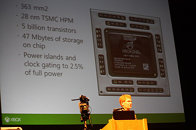Monday, November 3rd 2014

AMD to Give 20 nm Optical Shrinks to Console SoCs First
AMD has the unique distinction of supplying SoCs to all three leading game console vendors simultaneously - Microsoft, Sony, and Nintendo. The company, like NVIDIA, is looking forward with perched eyes for manufacturing partner TSMC to get its 20 nanometer silicon fabrication node running full-cylinders. Unlike NVIDIA, which may use the new process to shrink its GPUs, or launch bigger chips based on its "Maxwell" architecture, AMD will treat its console SoCs with optical-shrinks to the new nodes first, so the company could immediately eke out better margins, as console gamers upgrade to Xbox One or the PlayStation 4.
AMD's SoC for the Xbox One, could be the first in line for this optical shrink to 20 nm. This chip features a transistor count of 5 billion, and houses eight 64-bit x86 CPU cores, and a 768 SP GPU based on the Graphics CoreNext architecture; 48 MB of on-die cache, and a quad-channel DDR3 IMC. The chip also features an integrated core logic. AMD's chip for the PlayStation 4 features design inputs from Sony. The chip features the same CPU component, but a 1152 SP GPU, and a 256-bit wide GDDR5 memory interface, wired to 8 GB of memory that's virtualized for both system- and graphics-memory. The 20 nm shrinks of both chips are expected to lower not just manufacturing costs, but also step up energy-efficiency, which could then let Microsoft and Sony save additional costs on other components, such as power and cooling.
Source:
Expreview
AMD's SoC for the Xbox One, could be the first in line for this optical shrink to 20 nm. This chip features a transistor count of 5 billion, and houses eight 64-bit x86 CPU cores, and a 768 SP GPU based on the Graphics CoreNext architecture; 48 MB of on-die cache, and a quad-channel DDR3 IMC. The chip also features an integrated core logic. AMD's chip for the PlayStation 4 features design inputs from Sony. The chip features the same CPU component, but a 1152 SP GPU, and a 256-bit wide GDDR5 memory interface, wired to 8 GB of memory that's virtualized for both system- and graphics-memory. The 20 nm shrinks of both chips are expected to lower not just manufacturing costs, but also step up energy-efficiency, which could then let Microsoft and Sony save additional costs on other components, such as power and cooling.

44 Comments on AMD to Give 20 nm Optical Shrinks to Console SoCs First
also, no word on the WiiU :(
It will be the same way with regular consumers who know nothing about the innards of console systems or are remotely interested to begin with. They hear PS4 is stronger, they flock to that side of the fence. Sometimes regardless of where their loyalty lies. You see how it has affected Xbox One sales.
I agree with you Petey, they shouldn't advertise this too much, but it can't be helped honestly. Something that gets upgraded will get press no matter what. Like the stupid iphone versions. Not much difference there, but people know about it.
Keeping it with MS, the original 360 got 3 revisions where the exterior stayed the same but internally it also had die shrinks etc, the last, Codename Jasper, would be the best version to have in terms of failure rate and energy consumption but by far the biggest share of consumers wont know shit about that.
It would immediately place them as 1080p equal to Sony and end all the "talk."
They can always "blame" it on die shrink "improvements." :)
It's kind of funny/sad AMD is behind every segment including consoles
There was no issue/shitstorm when Xbox One with Kinect owners got Kinect features "removed" in order to pump out more CPU power for higher resolution.
Just like there is no issue/shitstorm with consumers buying Apple products weeks/days before a new replacement product arrives.
I think MS could in fact sell it as revision 2.0, much like the AIB GPU companies do with better cooling or components. I don't think MS will pass the savings on to consumers as quickly as they have with the recent price cut.
And there is difference between Mac models and consoles, which are marketed as different (Macs) and single (console) products.
And about Kinect, there cant be shitstorm if the game as such simply doesnt use Kinect.
Ideally, if MS can somehow increase their performance with the die shrink then customers win.
The Entire Halo Master Chief Collection is 1080p 60fps.recent price cut on the Xbox One is temporary. Just for the holiday's. It will go back up to its MSRP after January 3rd.
Scroll down to list of revisions. Die shrinks are not consumer relevant with consoles. They bring no performance changes because consistency is the entire point of them. Unless you're batshit crazy Nintendo that is, then you get the "new 3DS" half step BS.
ms just has to live with an inferior console in terms of a performance for this generation.
Don't get me wrong, I don't have either a PS4 or Xbox One and don't want either.I understand your point, but wasn't one of the reasons for consoles moving to x86 CPUs was to be able to "scale" to the hardware available?
All already known here because of some good YouTubers who they blew apart poopsoft and their 30FPS is better BS.
With some of the Dev complaints I've heard about the CPU being a touch slow, I could reasonably see both Sony and MS bumping the clockspeed on the CPU side of the SoC a bit. I've been playing with the Jaguar based Athlon 5350 and minor speed bumps really have very little effect on temps- a jump to ~2.0ghz should be manageable on old consoles and easy on any revision with a die shrink.
I think boosting the GPU clocks would present heat issues for the original SoCs.